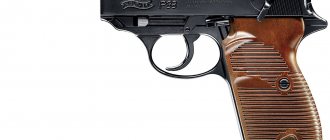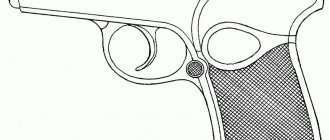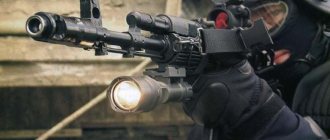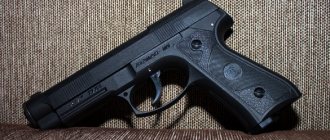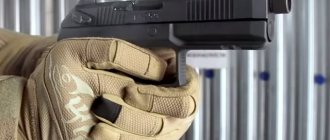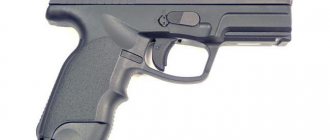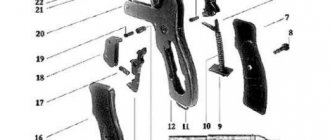Home | Weapons | Pistols | Russia / USSR | S4M and SMEs
Pistol S4M
Pistol SME
The Soviet silent double-barreled pistol S4 and, later, S4M was developed in the mid-1960s for special operations for PZ / PZA / PZAM ammunition of 7.62 mm caliber (7.62 × 63 mm), based on the intermediate cartridge 7.62 ×39. Silent pistols S4 and S4M were designed to use 7.62x63 PZ/PZA/PZAM cartridges. They differ from SP-3 in the length of the sleeve and the shape of the piston. In addition, in cartridges of the “PZ” family, the bullet from the 7.62x39 mm intermediate cartridge is almost completely recessed into the cartridge case and only a small part of its tip protrudes outward. The larger size of the cartridge case made it possible to increase the charge, due to which the muzzle energy of the PZAM cartridge is 120 joules versus 80 for the SP-3.
The silent double-barreled pistol S4M had two barrels located vertically relative to each other. The recommended shooting distance is 10-12 m. The first shot was to hit the target, the second was to make a control shot to the head. The 7.62 mm ammunition had good penetrating effect.
The pistol was produced in two versions:
- S4 - the first model, chambered for 7.62×63 mm PZ
- S4M - modification chambered for the 7.62×63 mm PZAM cartridge (with a modified cartridge case design)
Subsequently, based on the design of the S4 and S4M pistols, the MSP silent pistol was developed.
The silent double-barreled pistol MSP "Groza" (Small Special Pistol) was developed at TsNIITochmash chambered for the 7.62x38 mm SP-3 cartridge for the needs of the USSR KGB and GRU special forces in 1972. MSP has two barrels located in a vertical rotary package. Two SP-3 cartridges are connected by a clip and inserted into the chambers of the barrel block. The latter is made rotary for loading and removing cartridges. To fire a shot, you need to manually cock the two hammers of the pistol; this is done using a lever located under the trigger guard in the stowed position. The lever is pulled down until it stops, after which it can be returned to its original position and fire or the pistol can be put on a non-automatic safety.
There is an automatic mechanism that prevents the triggers from being released when the barrels are unlocked. When firing from an SME, a shot is fired first from the lower barrel, then from the upper - the trigger mechanism located in the handle and rear of the pistol is responsible for the order. After two shots, the pistol needs to be reloaded. To do this, press the barrel block lock and it rotates around its axis forward and down. Spent cartridges are removed manually using a clip. It should be noted that for some time they pose a certain danger to the shooter, since the cooling of the powder gases and the drop in pressure inside the cartridge case do not occur immediately. You can install a new clip in the free space and shoot again. The pistol sight consists of a non-adjustable front and rear sight located on the top edge.
Both silent pistols were adopted by special forces in the first half of the 70s of the last century, but reliable and comprehensive information about their use has not appeared for almost forty years. The same is true with information on C4M.
A little bit of history
The C4 pistol was developed in the mid-60s of the last century. The weapon was created under the P3 (“Snake”) cartridge and its subsequent design modifications - P3A and P3AM. The caliber of these cartridges is 7.62 mm. The main feature of these ammunition is that they have a large thick-walled cartridge case (length 63 mm), and this, in turn, provides a huge muzzle energy of 120 J due to the larger charge of gunpowder, which is one third more than the muzzle energy of SP-type cartridges. 3. Another feature of these cartridges is that their bullet is almost completely recessed into the cartridge case, and only a small tip protrudes outward.
Double-barreled silent pistol C4
Subsequently, the C4 and C4M pistols became the basis for the creation of a new pistol - the SME.
The road to the Black Sea resorts: the M-4 Don toll highway is preparing for another reconstruction
The M-4 Don highway, familiar to many Russians, like other toll roads in the Russian Federation, is in trust management of the state. This route goes to resorts located on the Black Sea coast, and drivers must pay to travel along sections of this highway. This road is in high demand and is often congested. In order to get rid of bottlenecks and problem areas on the M-4, the state company is carrying out reconstructions. One of them is waiting for a site in the Rostov region.
As the press service of Avtodor said, preparatory work has already begun on the M-4 for the reconstruction of the bridge across the Seversky Donets River. The facility, located at the 931st kilometer of the Don highway, served for more than 50 years. It is known that during 2022, builders intend to dismantle the old structures of the right bridge and begin erecting new supports.
For now, the formation of a construction camp continues at the site of the planned work. Active work on the construction of the technological bridge will begin in the second half of this month. With the help of this temporary structure, bridge workers will dismantle the old bridge.
The state-owned company recalled that the right bridge, going in the direction of Moscow, was built back in 1966, the passage through it was closed in 2019. In the summer of the same year, the construction of a temporary bridge across the Seversky Donets River was completed: now it is along it that trucks and cars move in the direction of Moscow from Rostov-on-Don. It is organized in two lanes, and the maximum permitted speed is 40 km/h (during the reconstruction of the right bridge).
Also, traffic on the left bridge is now maintained: drivers of trucks and cars can move along it when traveling in the direction from Moscow to Rostov-on-Don. It is worth noting that during the work the traffic pattern on this section will not change. According to the plan, construction will take 34 months.
As it became known at the end of last year, another reconstruction was completed on sections of the M-4 Don toll highway in the Tula and Voronezh regions. We are talking about sections from 275 to 287 and from 715 to 741 kilometers, respectively. In the first case, we are talking about the so-called “Tula roller coaster”: the third stage of work was completed here, road workers leveled the longitudinal profile of the route, removing sharp elevation changes (because of them, the section received its unofficial name).
In the Voronezh region, work has been completed to bypass the village of Verkhniy Mamon to the Bogucharka River. In the future, reconstruction of the next 36 kilometers of the route is expected - from kilometer 741 to kilometer 777. This section will open to traffic in 2023. Here road workers plan to change the longitudinal and transverse profile of the route, in addition, three new transport interchanges will be built.
Weapon design and principle of operation
The weapon has a rather interesting design, not similar to the standard design of pistols. It is more like a sideflint design.
Design
The silent pistol has a double-barreled design, in which the barrels are assembled into a single block and placed one above the other in a vertical plane. The pistol is not self-loading. To load and unload weapons, special 2-round clips made of metal are used.
Design of the CM4 pistol
Single action trigger. The cocking process is carried out using a special lever, which is located in the pistol grip. The figure shows how the cocking process is performed.
Cocking the CM4 pistol
The safety is located at the top left side of the pistol grip. On the reverse side of the trigger there is a latch for the pistol barrel block.
The pistol sight is open.
Operating principle
The recommended shooting distance was about 10-12 meters. According to the designers, it was necessary to hit/neutralize the target with the first shot, and to fire the so-called “control shot to the head” with the second shot. As for the sound of the shot, there was none at all, but only the characteristic clicks of the triggers hitting the firing pins were heard.
Cartridge SP3
The 7.62x63 mm pistol cartridge looked very much like the 1943 model cartridge, because it had a 7S62 bullet and had a completely acceptable penetration effect. Quiet shooting was ensured by the design of a special cartridge used in weapons. Inside the cartridge case, between the powder charge and the bullet, there is a piston consisting of a piston and a telescopic rod. When the gunpowder is ignited by the primer, a piston moves and pushes the bullet out. That, in turn, passes through a rather short barrel with 6 grooves and stabilizes at the exit from the barrel. Sealing of powder gases is ensured by deformation of the cartridge case when the piston moves (it practically levels out and becomes cylindrical). This eliminates the sound and flame of the shot.
Design of cartridge SP3
Reliant 4-barrel compact pistol
Heizer Defense and Double Tap are today one of the leading manufacturers of small-sized pocket pistols, and in particular such a famous and popular type as the “Derringer”. However, other companies are trying to get a place in the sun and “chew” some of the market for small-sized pocket pistols. One such company is the young company Edge Arms, which is actively seeking its niche in the small-sized pistol segment.
Edge Arms Reliant Compact Pocket Pistol
The Reliant pistol, which is offered by Edge Arms, has four barrels and, depending on the buyer’s preferences, it can be chambered for .22 Magnum (5.6 mm), .17 HMR (4.37 mm) or .380 ACP (9x17 mm). The concept of a four-barreled pistol is not new; for example, the Mossberg Brownie pistol was created using a similar design.
Mossberg Brownie Small Pocket Pistol
The Reliant also bears similarities to another four-barreled pistol, the COP 357, chambered for the fairly large .357 Magnum cartridge (9x32mm). The COP 357 pistol was not successful on the market and probably one of the reasons was the use of a cartridge that was too powerful for such a compact pistol.
Cartridges .22 Long, .22 LR, .22 Winchester Magnum Compact pocket pistol COP 357
Each barrel of the Reliant pistol is 73.66 mm long, and the barrels are interchangeable for models chambered for .22 Magnum and .17 HMR cartridges. The pistol grip can be used to store rimfire cartridges.
.17 Hornady Magnum Rimfire cartridge
Overall, the Reliant pistol is a simple flip-barrel pistol with a double-action trigger. The pistol does not have a safety mechanism. For safety reasons, Edge Arms has increased the trigger pull to 4.5 kg. Compared to pistols from Heizer Defense and Double Tap, the Reliant isn't exactly a thin pistol, but at 20.6mm it's certainly thinner than most pistols. Even when equipped with a pistol grip of other sizes, its thickness does not exceed 24 mm.
There is no data yet on the weight characteristics of the Reliant pistol, which likely indicates that the pistol is still in the design development stage. It is known that the pistol will reach 133.35 mm in length and 108 mm in height.
Edge Arms Reliant Compact Pocket Pistol
Sources indicate that Edge Arms plans to initially launch the Reliant in black with an anodized aluminum frame and phosphated steel barrels. In the future, it is planned that the pistol will be produced in Cerakote color.
It is known that Edge Arms plans to produce a Reliant pistol with an integrated under-barrel laser designator.
There's no doubt that the concealed carry pistol market is a lucrative market, but only time will tell whether Reliant's compact pocket pistol can carve out a piece of that market.
Application
As for the practical use of weapons, there is no information or facts.
It is reliably known that the C4 pistol and its modification were in service with army special forces and KGB forces.
Sectional view of P3AM cartridge
After the collapse of the Soviet Union, a certain number of S4Ms still remained in service. Today their fate is unknown.
Difference between N4M and its predecessor K4M
The H4M/HR16DE power unit replaced the outdated K4M engine, also known as QR16DE. The engine has undergone extensive modernization.
- The timing drive has been changed. Now the drive has become a chain drive, and therefore a more reliable and safe mechanism.
- The design of the cylinder head has changed significantly. It had new camshafts installed and an injector was added to each cylinder. Now there are two of them on each cylinder. The hydraulic lifters have disappeared from the engine. Now, according to the manufacturer’s recommendation, it is necessary to adjust the thermal clearances of the valves after 100 thousand kilometers. However, experienced mechanics advise doing this procedure at 80 thousand km. The intake shaft has changed, but the phase control system on it has been retained.
- The replacement of the cast iron BC with an aluminum block was of great importance. Casting the BC from aluminum greatly reduced the weight of the motor. As a result of replacing the BC material, the load on the suspension and transmission was reduced, thereby increasing their service life. The inertia of the car has decreased, but the dynamics have increased. Due to the fact that aluminum has greater thermal conductivity, the time required to warm up the engine has been reduced. This fact helps to save fuel. The engine has become much more economical, powerful and environmentally friendly. H4M complies with Euro 5.
- Over the years of production, the engine was constantly improved. In 2016, the N4Mk internal combustion engine, produced in Russia, began to be produced with all the latest modifications.
- On the H4MK the compression increased to 10.7.
- Power at 5800 rpm became equal to 110 hp.
This power unit began to be installed on Lada X-Ray and Lada Vesta. With all the changes, the engine still runs well on 92 gasoline, which is undoubtedly a plus.
Options, modifications of the pistol
In total, 2 versions of this type of pistol were created, the second of them was a modification of the first. The options are as follows:
- pistol C4 - the original model of a pistol chambered for 7.62x63 mm;
- S4M pistol is a modification of the original version chambered for the new P3AM cartridge with a modified cartridge case.
S4 pistol and P3 cartridges
The S4 pistol became the basis for the creation of a new silent pistol SME.
Cars with this engine
HR16DE, also known as H4M, was installed on the following Nissan models: Bluebird Sylphy, Wingroad, NV200, Micra, Cube, Versa, Grand Livina, Note, Qashqai, Latio, Tiida, Juke, Sentra.
H4M became the power unit on the following Renault models: Sandero Stepway, Duster, Sandero, Logan, Kaptur, Fluence.
In 2015, N4M rolled off the AvtoVAZ assembly line for the first time. They began to equip Lada Xray and Lada Vesta cars. In Russia, this engine was called H4Mk.
Service Features
As can be seen from what was written above, H4M does not have many weak points. But in order to avoid additional problems, it must be serviced in a timely and efficient manner.
Replacing spark plugs
This engine does not have hydraulic compensators. Therefore, manufacturers recommend adjusting the valves every 100 thousand kilometers. The procedure is expensive and complicated, and not all service stations undertake it. The fact is that for adjustment you need to have a set of scarce pushers, which have 26 sizes. Experienced mechanics recommend not delaying this activity and adjusting the thermal gaps after 80 thousand km.
Replacing the timing chain
On the N4M engine, a high-quality metal chain is installed on the timing drive. It is recommended to change it after 200,000, but it is better to replace the timing chain at a mileage of 150 thousand km.
